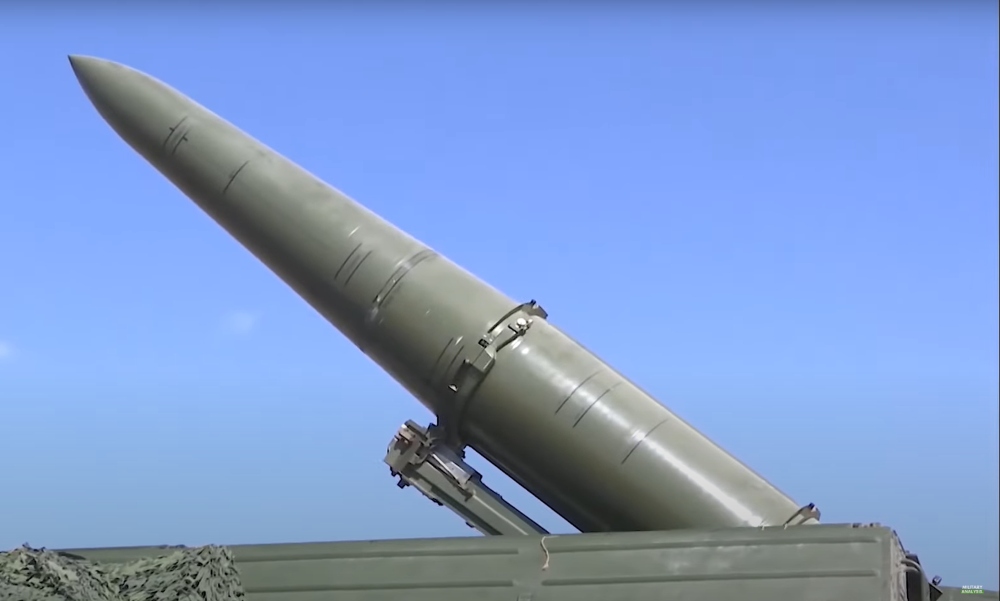 Parler
Parler Gab
Gab
- Russia modified Iskander-M and Kinzhal missiles to execute sharp terminal-phase maneuvers, reducing Ukraine's interception rate from 37 percent (August) to six percent (September). Ukrainian officials call this a "game-changer," demonstrated by successful strikes on key targets like a Turkish drone factory and EU/British offices in Kyiv.
- Iskander missile has a 500 km (310.7 mi) range, hypersonic submunitions (Mach 10+) and nuclear/conventional payloads. It could strike Eastern Europe (Poland, Baltics, Germany) with minimal warning.
- Ukraine shares real-time engagement data with Raytheon and Lockheed Martin, but U.S. officials admit countermeasure improvements lag behind Russia's evolving tactics. Patriot systems remain Ukraine's most effective defense, but shortages persist.
- Ukrainian President Volodymyr Zelensky warns Russia plans winter blackout campaigns (like 2022–2023) and hints at Ukrainian retaliatory strikes on Moscow's infrastructure. U.S. considers supplying Tomahawk cruise missiles (2,500 km range) to target Russian energy sites—potentially escalating the conflict.
- Russia's rapid adaptation outpaces Western defenses, risking obsolescence of current systems without urgent countermeasures. Ukraine braces for winter escalation as allies debate further aid, raising questions about Kyiv's long-term defense sustainability and geopolitical risks.
Western defense industry scrambles to adapt
Ukraine shares real-time engagement data with the U.S. Department of Defense and U.S. defense manufacturers—including Raytheon, which produces the Patriot system, and Lockheed Martin, maker of its interceptor missiles—to help refine countermeasures. However, officials admit that "those improvements often lagged behind Moscow's evolving tactics." A U.S. Defense Intelligence Agency report covering April to June 2025 confirmed Ukraine's struggles, stating that Russian "enhancements enable their missiles to change trajectory and perform maneuvers rather than flying in a traditional ballistic trajectory." Despite these challenges, Patriot systems remain Ukraine's most effective defense against ballistic missiles, though shortages persist. Ukrainian President Volodymyr Zelensky has warned that Russia is likely preparing another winter campaign targeting Ukraine's power grid—a tactic Moscow has employed in previous years. "Russia is once again trying to hit Ukraine with a blackout this year," Zelensky said on Sept. 28. He also hinted at potential retaliatory strikes against Russian infrastructure, stating that Ukraine could respond "in kind against Russia's own capital" if Kyiv faces severe blackouts. Meanwhile, the U.S. is reportedly considering supplying Ukraine with long-range Tomahawk cruise missiles (range: 2,500 km or 1,553.4 mi) to strike Russian energy infrastructure—a move that could escalate tensions further. Kremlin spokesperson Dmitry Peskov dismissed the reports, claiming that NATO and the U.S. "already supply intelligence to Ukraine on a regular basis."Broader implications for NATO and Ukraine
The missile upgrades underscore Russia's ability to adapt quickly on the battlefield, outpacing Western defense adjustments. While Ukraine has received additional Patriot components from Germany and Norway, analysts warn that Russia's evolving tactics could render existing air defenses obsolete without rapid countermeasures. As winter approaches, Ukraine braces for intensified strikes while Western allies debate further military aid—raising critical questions about the sustainability of Kyiv's defense strategy and the broader geopolitical risks of escalation. For now, Russia's missile advancements have shifted the balance, forcing Ukraine and its allies into a reactive stance—one that may require drastic new measures to counter Moscow's technological edge. Watch the video below about Russia's Iskander-M missile wiping out another Ukrainian S-300 air defense system. This video is from the TREASURE OF THE SUN channel on Brighteon.com. Sources include: ZeroHedge.com Brighteon.ai Independent.co.uk AeroTime.aeroGaza celebrates as Israel officially approves U.S.-brokered peace plan
By Zoey Sky // Share
By Gregory Van Dyke // Share
U.S. secures $6 billion icebreaker deal with Finland to counter Russia, China in Arctic
By Willow Tohi // Share
By Gregory Van Dyke // Share
Governments continue to obscure COVID-19 vaccine data amid rising concerns over excess deaths
By patricklewis // Share
Tech giant Microsoft backs EXTINCTION with its support of carbon capture programs
By ramontomeydw // Share
Germany to resume arms exports to Israel despite repeated ceasefire violations
By isabelle // Share










